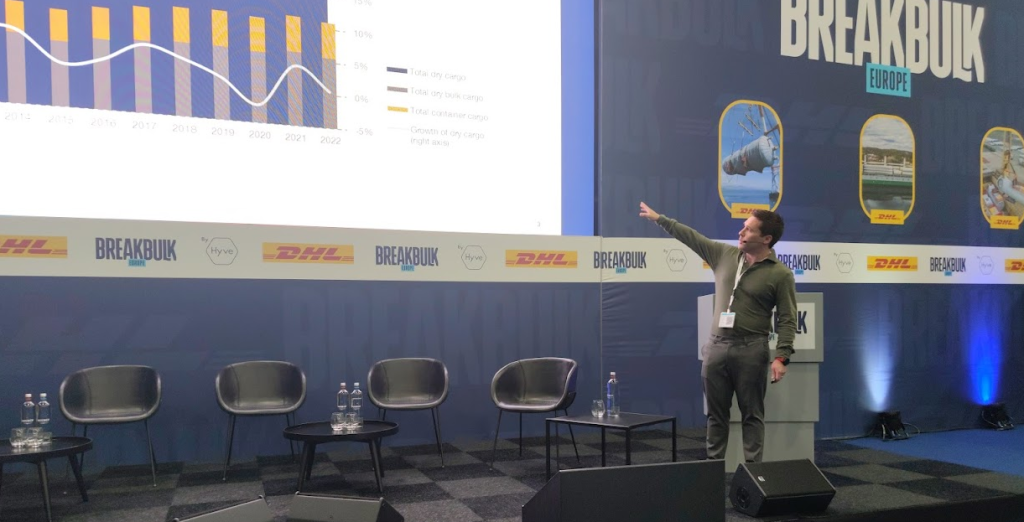
The global maritime industry plays a pivotal role in international trade, facilitating the movement of goods and resources across borders. Within this vast industry, the breakbulk and project cargo sector stands out as a vital component. In recent years, the multipurpose vessel (MPV) segment has witnessed significant growth, particularly in Europe. In this article, we will delve into Drewry’s insightful analysis, by Peter Molloy during the Breakbulk Europe event in Rotterdam, of MPV growth in Europe, exploring the factors contributing to this expansion and the potential implications for the shipping industry.
Understanding the Multipurpose Vessel (MPV) Segment
Before delving into the specifics of MPV growth in Europe, it is crucial to grasp the nature of the multipurpose vessel segment. Multipurpose vessels, as the name suggests, are versatile ships capable of carrying a wide range of cargo, including breakbulk and project cargoes. These vessels possess adaptable cargo handling capabilities, allowing for efficient loading and unloading operations. MPVs typically offer a combination of containerized and non-containerized cargo services, accommodating diverse requirements and catering to the needs of various industries.
Key Factors Driving MPV Growth in Europe
1. Recovering Global Economy
The global economy’s gradual recovery from the impact of the COVID-19 pandemic has had a positive influence on the growth of the MPV segment. As economic activities resume and industries regain momentum, the demand for breakbulk and project cargo transportation has increased. Europe, being a significant player in international trade, has witnessed a surge in trade volumes, driving the demand for MPV services.
2. Infrastructure Development Projects
Europe has witnessed a notable increase in infrastructure development projects, including the construction of roads, bridges, power plants, and renewable energy installations. These projects require the transportation of heavy and oversized equipment, which is ideally suited for MPVs. The versatility of multipurpose vessels enables efficient and cost-effective transportation of project cargoes, making them a preferred choice for such ventures.
3. Shift Towards Sustainable Energy Sources
The global focus on sustainable energy has resulted in a substantial shift towards renewable energy sources. Europe, in particular, has been at the forefront of this transition, investing in wind farms, solar energy projects, and other green initiatives. The transportation of wind turbine components, solar panels, and other renewable energy equipment has contributed significantly to the growth of the MPV segment in the region.
4. Increased Demand for Breakbulk Cargo
The demand for breakbulk cargo transportation has also played a crucial role in the expansion of the MPV segment in Europe. Breakbulk cargoes, characterized by individual items or parcels of cargo that are not containerized, require specialized handling and transportation. MPVs, with their flexible cargo handling capabilities, are well-suited for transporting breakbulk cargoes, offering efficient and reliable services to shippers.
5. Geographical Advantages of European Ports
Europe boasts a strategic geographical location, serving as a gateway between major global markets. The region’s extensive port network, complemented by well-developed infrastructure and efficient logistics operations, has positioned European ports as key hubs for international trade. This favorable geographical advantage has further fueled the growth of the MPV segment in Europe, attracting shipping lines and cargo owners to leverage the region’s connectivity and accessibility.

Implications for the Shipping Industry
The remarkable growth of the MPV segment in Europe carries several implications for the shipping industry as a whole. Let us explore some of the key implications:
1. Enhanced Service Offerings
With the increasing demand for MPV services, shipping lines have expanded their fleet of multipurpose vessels. This expansion allows them to offer a broader range of services and cater to the specific needs of different industries. By enhancing their service offerings, shipping lines can provide more customized solutions, ensuring efficient and reliable transportation of breakbulk and project cargoes.
2. Opportunities for Port Development
The growth of the MPV segment in Europe has presented opportunities for port development and expansion. To accommodate larger and more specialized MPVs, ports may need to upgrade their infrastructure, including berths, cranes, and cargo handling equipment. This investment in port infrastructure not only facilitates the growth of the MPV segment but also strengthens the overall maritime trade ecosystem.
3. Collaboration and Partnerships
The dynamic nature of the MPV segment necessitates collaboration and partnerships between various stakeholders. Shipping lines, port authorities, cargo owners, and logistics providers must work together to optimize operations, streamline processes, and enhance overall efficiency. Such collaborations can lead to innovative solutions, improved service quality, and a more sustainable and resilient shipping industry.
Final Words
Drewry’s insightful analysis sheds light on the significant growth of the MPV segment in Europe. Factors such as the recovering global economy, infrastructure development projects, the shift towards sustainable energy, increased demand for breakbulk cargo, and the geographical advantages of European ports have propelled this expansion. The implications for the shipping industry include enhanced service offerings, opportunities for port development, and the need for collaboration and partnerships. As the MPV segment continues to flourish, it is essential for industry stakeholders to adapt, innovate, and capitalize on the opportunities presented by this thriving sector.

